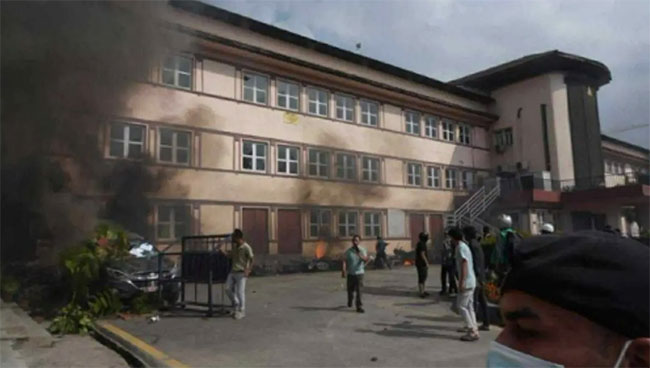Nepal’s Supreme Court and ministers’ homes set on fire amidst public revolt
September 9, 2025 06:48 pm
VIDEO | Nepal: Protesters set the Supreme Court in Kathmandu on fire amid anti-government protests.#Nepalprotest
— Press Trust of India (@PTI_News) September 9, 2025
(Full video available on PTI Videos - https://t.co/n147TvrpG7) pic.twitter.com/1ZlWODFC6C
Nepal’s Parliament building, Supreme Court, and residences of several senior leaders were set ablaze on Tuesday as anti-government protests spiralled out of control, minutes after Prime Minister K P Sharma Oli resigned.
Visuals shared by news agency PTI confirmed the fire at the Supreme Court, while the storming and burning of Parliament was reported by television channels and attested to by multiple reporters on the ground.
Oli stepped down shortly after hundreds of demonstrators entered his office shouting anti-government slogans. Reports also suggested he is preparing to flee Nepal, with speculation of a possible trip to Dubai under the pretext of medical treatment. ET Online could not independently verify these claims.
Hours earlier, protesters had torched Oli’s private residence in Balkot, Bhaktapur, demanding accountability for Monday’s violent clashes that left at least 19 people dead. The government had revoked its controversial ban on social media platforms on Monday night in an attempt to defuse tensions, but the move failed to pacify crowds, with anger now morphing into direct demands for the Prime Minister’s resignation.
Nepal Gen Z protests over corruption
The wave of demonstrations, described by organisers as ‘protests by Gen Z,’ has been fuelled by frustration over corruption and lack of economic opportunities.
‘The protest was intended, first and foremost, against the rampant corruption in government,’ one protester wrote in an email to Reuters, signing off as ‘A concerned Nepali citizen.’
Many young Nepalis had taken to social media to highlight the ‘luxurious lives of the families and children of corrupt politicians and civil servants.’ Oli’s government responded by imposing a sweeping social media ban last week, which critics called an attempt to throttle free speech. The government, however, defended it, citing misuse of platforms to spread misinformation.
Oli, 73, sworn in for his fourth term as prime minister in July last year, expressed sorrow over the bloodshed but blamed ‘infiltration from different selfish centres’ for the unrest. He has not directly addressed allegations of corruption. Two of his cabinet colleagues resigned late on Monday, saying they could not continue on moral grounds.
What we know so far
The violence has spread well beyond Kathmandu. The home of Minister for Communication Prithvi Subba Gurung was set ablaze, while the residences of Deputy Prime Minister Bishnu Paudel, Nepal Rastra Bank Governor Biswo Paudel and former Home Minister Ramesh Lekhak were also attacked. Demonstrators attempted to storm the homes of former Prime Minister Sher Bahadur Deuba and opposition leader Pushpa Kamal Dahal.
Curfews have been declared in several regions — including Kathmandu, Lalitpur, Kavrepalanchok, Koshi Province, Birgunj and Makwanpur — with highways, markets, and public spaces shuttered under heavy police deployment. Yet protesters continued to defy restrictions, clashing with security forces in the capital, where tear gas was used to disperse stone-throwing crowds.
Adding to the climate of uncertainty, local television channels broadcast reports speculating that Oli might be preparing to flee the country, with helicopters spotted hovering over Lalitpur’s Bhaisepati area.
A joint statement from the embassies of Australia, Finland, France, Japan, South Korea, the UK, Norway, Germany and the US expressed sadness over the violence and urged all sides to avoid escalation and ensure fundamental rights are protected.
The storming of Parliament, Supreme Court, and Oli’s resignation together mark one of the gravest political crises for Nepal since it abolished its monarchy in 2008.
Source: Economic Times
--Agencies












